Modern biology is based on several unifying themes, such as the cell theory, genetics and inheritance, Crick's central dogma of information flow, and Darwin and Wallace's theory of evolution by natural selection. In this first unit we will examine these themes and the nature of science.
The Ancient Greek philosopher Anaxiamander (611-547 B.C.) and the Roman philosopher Lucretius (99-55 B.C.) coined the concept that all living things were related and that they had changed over time. The classical science of their time was observational rather than experimental. Another ancient Greek philosopher, Aristotle developed his Scala Naturae, or Ladder of Life, to explain his concept of the advancement of living things from inanimate matter to plants, then animals and finally man. This concept of man as the "crown of creation" still plagues modern evolutionary biologists (See Gould, S.J., Wonderful Life, 1989, for a more detailed discussion).
Post-Aristotlean "scientists" were constrained by the prevailing thought patterns of the Middle Ages -- the inerrancy of the biblical book of Genesis and the special creation of the world in a literal six days of the 24-hour variety. Archbishop James Ussher of Ireland, in the late 1600's calculated the age of the earth based on the geneologies from Adam and Eve listed in the biblical book of Genesis (note to the no-longer young: Phil Collins and Peter Grabriel were not in this Genesis). According to Ussher's calculations, the earth was formed on October 22, 4004 B.C. These calculations were part of Ussher's History of the World, and the chronology he developed was taken as factual, even being printed in the front pages of bibles. Ussher's ideas were readily accepted, in part because they posed no threat to the social order of the times; comfortable ideas that would not upset the linked applecarts of church and state.
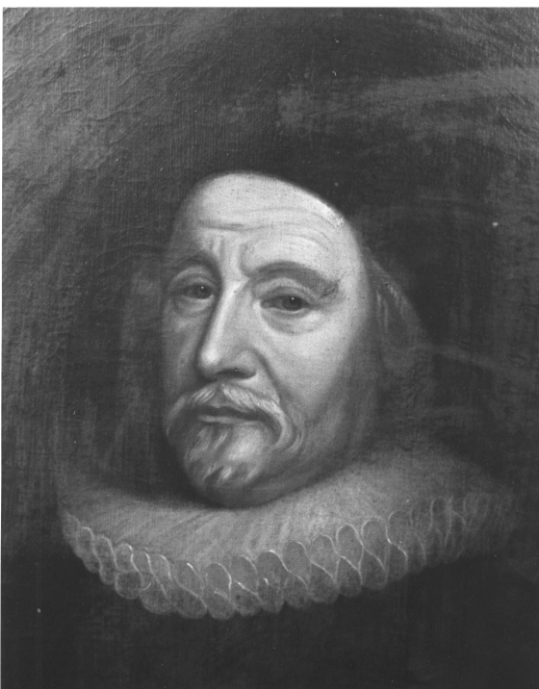
Archbishop James Ussher.
Often new ideas must "come out of left field", appearing as wild notions, but in many cases prompting investigation which may later reveal the "truth". Ussher's ideas were comfortable, the Bible was viewed as correct, therefore the earth must be only 5000 years old.
Geologists had for some time doubted the "truth" of a 5,000 year old earth. Leonardo da Vinci (painter of the Last Supper, and the Mona Lisa, architect and engineer) calculated the sedimentation rates in the Po River of Italy, and concluded it took 200,000 years to form some nearby rock deposits. Galileo, convicted heretic for his contention that the earth was not the center of the Universe, studied fossils (evidence of past life) and concluded that they were real and not inanimate artifacts. James Hutton, regarded as the Father of modern Geology, developed the Theory of Uniformitarianism, the basis of modern geology and paleontology. According to Hutton's work, certain geological processes operated in the past in much the same fashion as they do today, with minor exceptions of rates, etc. Thus many geological structures and processes cannot be explained if the earth is only 5000 years old.
Radiometric age assignments based on the rates of decay of radioactive isotopes, not discovered until the late 19th century, suggest the earth is over 4.5 billion years old. The Earth is thought older than 4.5 billion years, with the oldest known rocks being 3.96 billion years old. Geologic time divides into eons, eroas, and smaller units. An overview of geologic time may be obtained at http://www.ucmp.berkeley.edu/help/timeform.html.
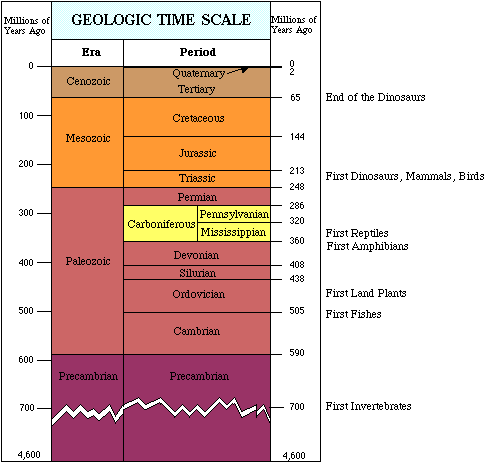
One way to represent geological time. Note the break during the precambrian. If the vertical scale was truly to scale the precambrian would account for 7/8 of the graphic. The above image is from http://www.clearlight.com/~mhieb/WVFossils/GeolTimeScale.html.
Erasmus Darwin (1731-1802; grandfather of Charles Darwin) a British physician and poet in the late 1700's, proposed that life had changed over time, although he did not present a mechanism. Georges-Louis Leclerc, Comte de Buffon (pronounced Bu-fone; 1707-1788) in the middle to late 1700's proposed that species could change. This was a major break from earlier concepts that species were created by a perfect creator and therefore could not change because they were perfect, etc.
Swedish botanist Carl Linne (more popularly known as Linneus, after the common practice of the day which was to latinize names of learned men), attempted to pigeon-hole all known species of his time (1753) into immutable categories. Many of these categories are still used in biology, although the underlying thought concept is now evolution and not immutability of species. Linnean hierarchical classification was based on the premise that the species was the smallest unit, and that each species (or taxon) belonged to a higher category.
Kingdom Animalia
Phylum (Division for plants) ChordataClass MammaliaOrder PrimatesFamily HominidaeGenus Homospecies sapiens
Linneus also developed the concept of binomial nomenclature, whereby scientists speaking and writing different languages could communicate clearly. For example Man in English is Hombre in Spanish, Herr in German, and Homo in Latin. Linneus settled on Latin, which was the language of learned men at that time. If a scientist refers today to Homo, all scientists know what he or she means.
William "Strata" Smith (1769-1839), employed by the English coal mining industry, developed the first accurate geologic map of England. He also, from his extensive travels, developed that Principle of Biological Succession. This idea states that each period of earth history has its own unique assemblages of fossils. In essence Smith fathered the science of stratigraphy, the correlation of rock layers based on (among other things) their fossil contents.
Abraham Gottlob Werner and Baron Georges Cuvier (1769-1832) were among the foremost proponents of catastrophism, the theory that the earth and geological events had formed suddenly, as a result of some great catastrophe (such as Noah's flood). This view was a comfortable one for the times and thus was widely accepted. Cuvier eventually proposed that there had been several creations that occurred after catastrophies. Louis Agassiz (1807-1873) proposed 50-80 catastrophies and creations.
Jean Baptiste de Lamarck (1744-1829) developed one of the first theories on how species changed. He proposed the inheritance of acquired characteristics to explain, among other things, the length of the giraffe neck. The Lamarckian view is that today's giraffe's have long necks because their ancestors progressively gained longer necks due to stretching to reach food higher and higher in trees. According to the 19th century of use and disuse the stretching of necks resulted in their development, which was somehow passed on to their progeny. Today we realize that only bacteria are able to incorporate non-genetic (aka nonheritable) traits. Lamarck's work was a theory that plainly stated that life had changed over time and provided (albeit an erroneous) mechanism of change.
Additional information about the biological thoughts of Lamarck is available by clicking here.
Charles Darwin, former divinity student, former medical student, secured (through the intercession of his geology professor) an unpaid position as ship's naturalist on the H.M.S. Beagle. The voyage would provide Darwin a unique opportunity to study adaptation and gather a great deal of proof he would later incorporate into the theory of evolution. On his return to England, Darwin began to catalog his collections and ponder the seeming "fit" of organisms to their mode of existence. He eventually settled on four main points of the theory.
In 1858, Darwin received a letter from Alfred Russel Wallace (1823-1913), in which Darwin's as-yet-unpublished theory of evolution and adaptation was precisely detailed. Darwin arranged for Wallace's letter to be read at a scientific meeting, along with a synopsis of his own ideas. To be correct, we need to mention that both Darwin and Wallace developed the theory, although Darwin's major work was not published until 1859 (On the Origin of Species by Means of Natural Selection). While there have been some changes to the theory since 1859, most notably the incorporation of genetics and DNA into what is termed the "Modern Synthesis" during the 1940's, most scientists today accept evolution as the guiding theory on which modern biology is based.
Recent revisions of biology curricula stressed the need for underlying themes. Evolution serves as such a universal theme. An excellent site devoted to Darwin's thoughts and work is available by clicking here. At that same site is a nice timeline showing many of the events mentioned above in their historical contexts.
Robert Hooke ( 1635-1703), one of the first scientists to use a microscope to examine pond water, cork and other things, referred to the cavities he saw in cork as "cells". Mattias Schleiden (in 1838) concluded all plant tissues consisted of cells. In 1839, Theodore Schwann came to a similar conclusion for animal tissues. Rudolf Virchow, in 1858, combined the two ideas and added that all cells come from pre-existing cells, formulating the Cell Theory. Thus there is a chain-of-existence extending from your cells back to the earliest cells, over 3.5 billion years ago. The cell theory states that all organisms are composed of one or more cells, and that those cells have arisen from pre-existing cells.
In 1953, James Watson and Francis Crick developed the model for deoxyribonucleic acid (DNA), a chemical that had (then) recently been deduced to be the physical carrier of inheritance. Crick hypothesized the mechanism for DNA replication and further linked DNA to proteins, referred to as the central dogma, with information flowing from DNA to RNA (ribonucleic acid) and thence to proteins. Later in this course we will explore the central dogma in greater detail. In short, the central dogma explains the influence of heredity (DNA) on the organism (proteins).
Theromodynamics cover the laws governing energy transfers, and thus the basis for life on earth. Two major laws are known: the conservation of matter and energy, and entropy. These will be discussed in more detail later in class. The universe is composed of two things-- matter (atoms etc.) and energy. Albert Einstein realized the relationship between them (E=mc2) and ultimately created the atomic age.
Evolutionary theory and the cell theory provide us with a basis for the interrelation of all living things. We also utilize Linneus' hierarchical classification system, adopting (generally) five kingdoms of living organisms. Viruses, as discussed later, are not considered living. Click here for a table summarizing the five kingdoms. Recent studies suggest that there might be a sixth Kingdom, the Archaea.
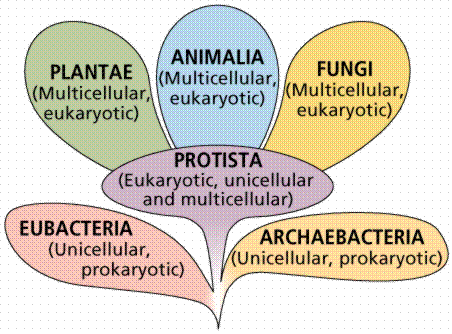
A simple phylogenetic representation of three domains of life" Archaea, Bacteria (Eubacteria), and Eukaryota (all eukaryotic groups: Protista, Plantae, Fungi, and Animalia). Image from W.H. Freeman and Sinauer Associates, used by permission.
Monera, the most primitive kingdom, contain living organisms remarkably similar to ancient fossils. Organisms in this group lack membrane-bound organelles associated with higher forms of life. Such organisms are known as prokaryotes. Bacteria (technically the Eubacteria) and blue-green bacteria (sometimes called blue-green algae, or cyanobacteria) are the major forms of life in this kingdom. The most primitive group, the archaebacteria, are today restricted to marginal habitats such as hot springs or areas of low oxygen concentration.
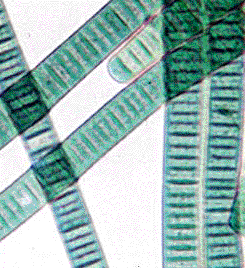
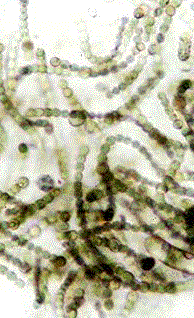
Representative photosynthetic cyanobacteria: Oscillatoria (left) and Nostoc (right). The above left image is cropped from gopher://wiscinfo.wisc.edu:2070/I9/.image/.bot/.130/Cyanobacteria/Oscillatoria_130. The above image right is cropped from gopher://wiscinfo.wisc.edu:2070/I9/.image/.bot/.130/Cyanobacteria/Nostoc_130.
Protista were the first of the eukaryotic kingdoms, these organisms and all others have membrane-bound organelles, which allow for compartmentalization and dedication of specific areas for specific functions. The chief importance of Protista is their role as a stem group for the remaining Kingdoms: Plants, Animals, and Fungi. Major groups within the Protista include the algae, euglenoids, ciliates, protozoa, and flagellates.
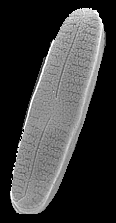
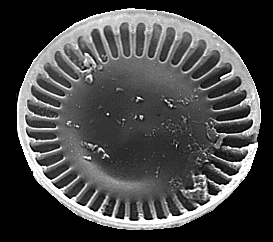
The above images of diatoms (Protista) are from http://WWW.bgsu.edu/departments/biology/algae/index.html. There are two basic types of diatoms: bilaterally symmetrical (left) and radially symmetrical (right).



The above images are Copyright 1994 by Charles J. O'Kelly and Tim Littlejohn, used by permission from: http://megasun.bch.umontreal.ca/protists/gallery.html.
Fungi are almost entirely multicellular (with yeast, Saccharomyces cerviseae, being a prominent unicellular fungus), heterotrophic (deriving their energy from another organism, whether alive or dead), and usually having some cells with two nuclei (multinucleate, as opposed to the more common one, or uinucleate) per cell. Ecologically this kingdom is important (along with certain bacteria) as decomposers and recyclers of nutrients. Economically, the Fungi provide us with food (mushrooms; Bleu cheese/Roquefort cheese; baking and brewing), antibiotics (the first of the wonder drugs, Penicillin, was isolated from a fungus Penicillium), and crop parasites (doing several billion dollars per year of damage).
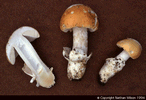

The above images are from http://www.cinenet.net/users/velosa/thumbnails.html.
Plantae (click here for more information about the Plantae) include multicelled organisms that are all autotrophic (capable of making their own food by the process of photosynthesis, the conversion of sunlight energy into chemical energy). Ecologically, this kingdom is generally (along with photosynthetic organisms in Monera and Protista) termed the producers, and rest at the base of all food webs. A food web is an ecological concept to trace energy flow through an ecosystem. Economically, this kingdom is unparalleled, with agriculture providing billions of dollars to the economy (as well as the foundation of "civilization"). Food, building materials, paper, drugs (both legal and illegal), and roses, are plants or plant-derived products.
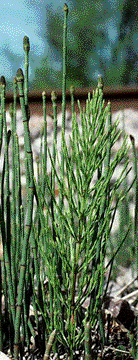

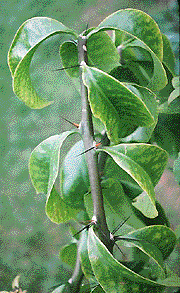
The above left image of species of Equisetum is cropped and reduced from gopher://wiscinfo.wisc.edu:2070/I9/.image/.bot/.130/Fern_Allies/Sphenophyta/Equisetum/E._arvense_and_E._laevigatum_KS. The above image (center) of Iris, is reduced and cropped from gopher://wiscinfo.wisc.edu:2070/I9/.image/.bot/.401/Flowering_Plants/Monocots/Iridaceae/Iris/Iris_pumula_habit. The above (right) image of Pereskia (Cactaceae) is reduced from gopher://wiscinfo.wisc.edu:2070/I9/.image/.bot/.401/Flowering_Plants/Dicots/Cactaceae/Pereskia/Pereskia_leafy_stem_RK.
Animalia consists entirely of multicelluar heterotrophs that are all capable (at some point during their life history) of mobility. Ecologically, this kingdom occupies the level of consumers, which can be subdivided into herbivore (eaters of plants) and carnivores (eaters of other animals). Humans, along with some other organisms, are omnivores (capable of functioning as herbivores or carnivores). Economically, animals provide meat, hides, beasts of burden, pleasure (pets), transportation, and scents (as used in some perfumes).
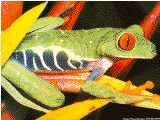
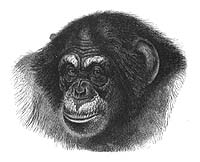
The above image of a jellyfish (left) is from http://www.smoky.org/~mtyler/bio/coelenterata.html. The center image of a tree frog is from http://frog.simplenet.com/froggy/images/wild28.gif. The drawing of the chimpanzee (right) is from http://www.selu.com/~bio/PrimateGallery/art/Copyright_Free02.html.
Science is an objective, logical, and repeatable attempt to understand the principles and forces operating in the natural universe. Science is from the Latin word, scientia, to know. Good science is not dogmatic, but should be viewed as an ongoing process of testing and evaluation. One of the hoped-for benefits of this course is that you will become familiar with the process of science.
In order to conduct science, one must know the rules of the game (imagine playing Monopoly or some other board game and having to discover the rules as you play! [which is what one does with a computer or videogame before buying the cheatbook]). The scientific method is to be used as a guide that can be modified. In some sciences, such as taxonomy and certain types of geology, laboratory experiments are not necessarily performed. Instead, after formulating a hypothesis, additional observations and/or collections are made from different localities.
Steps in the scientific method commonly include:
After a hypothesis has been repeatedly tested, a hierarchy of scientific thought develops. Hypothesis is the most common, with the lowest level of certainty. A theory is a hypothesis that has been repeatedly tested with little modification, e.g. The Theory of Evolution. A Law is one of the fundamental underlying principles of how the Universe is organized, e.g. The Laws of Thermodynamics, Newton's Law of Gravity.
Living things have a variety of common characteristics. Before continuing with this chapter, see how many of them you can list.
OK, now let's continue...
Biosphere: The sum of all living things taken in conjunction with their environment. In essence, where life occurs, from the upper reaches of the atmosphere to the top few meters of soil, to the bottoms of the oceans. We divide the earth into atmosphere (air), lithosphere (earth), hydrosphere (water), and biosphere (life).
Ecosystem: The relationships of a smaller groups of organisms with each other and their environment. Scientists often speak of the interrelatedness of living things. Since, according to Darwin's theory, organisms adapt to their environment, they must also adapt to other organisms in that environment. We can discuss the flow of energy through an ecosystem from photosynthetic autotrophs to herbivores to carnivores.
Community: The relationships between groups of different species. For example, the desert communities consist of rabbits, coyotes, snakes, birds, mice and such plants as sahuaro cactus (Carnegia gigantea), Ocotillo, creosote bush, etc. Community structure can be disturbed by such things as fire, human activity, and over-population.
Species: Groups of similar individuals who tend to mate and produce viable, fertile offspring. We often find species described not by their reproduction (a biological species) but rather by their form (anatomical or form species).
Populations: Groups of similar individuals who tend to mate with each other in a limited geographic area. This can be as simple as a field of flowers, which is separated from another field by a hill or other area where none of these flowers occur.
Individuals: One or more cells characterized by a unique arrangement of DNA "information". These can be unicellular or multicellular. The multicellular individual exhibits specialization of cell types and division of labor into tissues, organs, and organ systems.
Organ System: (in multicellular organisms). A group of cells, tissues, and organs that perform a specific major function. For example: the cardiovascular system functions in circulation of blood.
Organ: (in multicellular organisms). A group of cells or tissues performing an overall function. For example: the heart is an organ that pumps blood within the cardiovascular system.
Tissue: (in multicellular organisms). A group of cells performing a specific function. For example heart muscle tissue is found in the heart and its unique contraction properties aid the heart's functioning as a pump. .
Cell: The fundamental unit of living things. Each cell has some sort of hereditary material (either DNA or more rarely RNA), energy acquiring chemicals, structures, etc. Living things, by definition, must have the metabolic chemicals plus a nucleic acid hereditary information molecule.
Organelle: A subunit of a cell, an organelle is involved in a specific subcellular function, for example the ribosome (the site of protein synthesis) or mitochondrion (the site of ATP generation in eukaryotes).
Molecules, atoms, and subatomic particles: The fundamental functional levels of biochemistry.
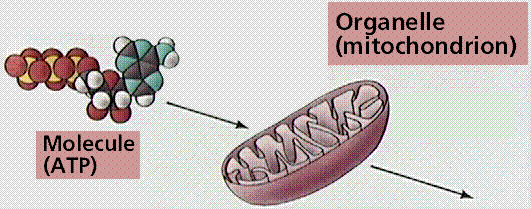
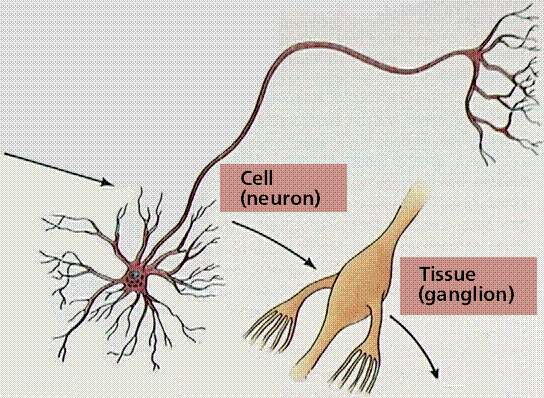
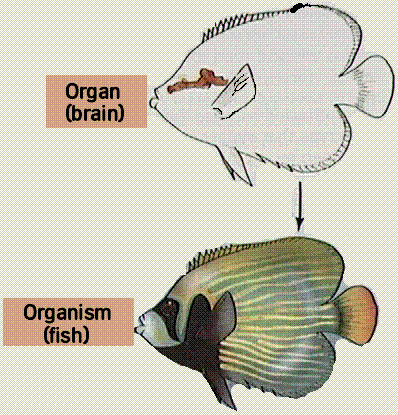
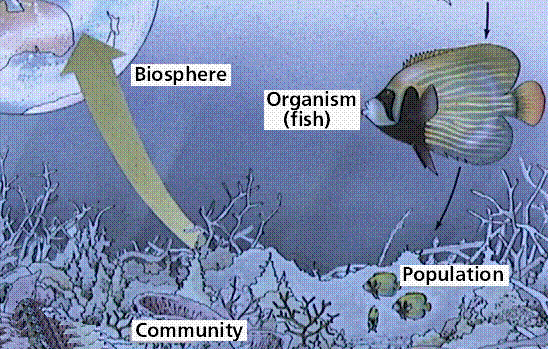
Organization levels of life, in a graphic format. Images from W.H. Freeman and Sinauer Associates, used by permission.
It is thus possible to study biology at many levels, from collections of organisms (communities), to the inner workings of a cell (organelle).
These learning objectives are taken from my Biology for Nonmajors class (BIO 102). I have tried to add a link to each that will direct you to a part of this chapter or another website that will facilitate your completion of the objective.
Back to Table of Contents | Go To CHEMISTRY I: ATOMS AND MOLECULES
Email: mj.farabee@emcmail.maricopa.edu![]()
Last modified: 2000/01/08:18:10:27
The URL of this page is: gened.emc.maricopa.edu/bio/BIO181/BIOBK/BioBookintro.html